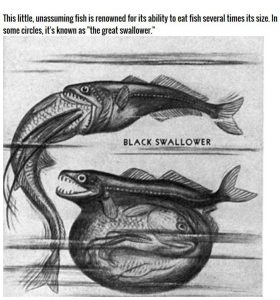Black Swallower Ocean Monster
The Black Swallower, (Chiasmodon niger), has to be one of the strangest fish we have come across. Thankfully, the Black Swallower is small and is found in the deep ocean because it has a voracious appetite. More on that later.
The Black Sawallower is a member of the Chiasmodontidae family. These fish are deep ocean dwelling fish and have a monster like appearance along with a monster appetite for fish much larger than itself that put the hungry Largemouth Bass to shame.
Great Swallower Swallowing Prey
Little is known about how Black Swallowers manage to consume their prey. Some however believe that they capture their prey with their tail and coil around it like a snake and then slowly swallow their prey. This seems unlikely.
Most snakes that have this ability are large and do not have teeth to hold on to their prey. They are able to kill their prey by squeezing the life out of them. The Black Swallower is not a large fish so it does not have the size or strength to do this like a python. However, their teeth are angled inwards in a way designed to prevent any prey from getting away.
 The Black Swallower is found in the deep ocean where there is no light at all. It is believed that they are able to locate their prey in the dark and bite onto their head, suffocating them. Their teeth prevent the prey from getting away and they are eventually able to swallow the fish whole.
The Black Swallower is found in the deep ocean where there is no light at all. It is believed that they are able to locate their prey in the dark and bite onto their head, suffocating them. Their teeth prevent the prey from getting away and they are eventually able to swallow the fish whole.
The Black Swallower has long pectoral fins each with about 13 rays. Their pelvic fins are very small with five rays. It has two dorsal fins but each one is different in shape. The first has 12 spines. The second dorsal fin only has one spine but has about 28 soft rays. The anal fin has one spine and about 28 soft rays – not ideal for spearing prey fish.
Black Swallower Distribution
The Black Swallower can be found in all of the worlds oceans. While some claim that they are only found in the tropics, research indicates that they are indeed found in higher latitudes. Their only reason for staying in an area is ample food. Warm water is not a reason for distribution as the water temperature is close to freezing at the depths in which they live.
The Black Swallower is found in deep water, known as the mesopelagic and bathypelagic zones, which range from 2,300 to 9,000 feet/700 to 2,745 meters. This is almost three kilometres deep or close to 2 miles.
Black Swallower Features and Size
As mentioned, the Black Swallower is not a large fish at all. Like many deep sea fish, this one does not grow larger than a foot with most being in the six to 8 inch range.
They have a long body that is compressed for its length. The Black Swallower does not have any scales, having a smooth soft skin to the touch.
The most striking feature of the Black Swallower is its large stomach. This fish evolved to eat large fish, much larger than its own body. It’s mouth is lined with super sharp teeth that dig into its prey preventing it from getting away.
Several years ago, an image surfaced of a Black Swallower that had managed to swallow a snake mackerel. Scientists estimate that the Black Swallower can consume fish up to ten times their size and twice its length.
To help it swallow prey, the lower jaw protrudes past the upper. The teeth interlock when the mouth is closed. Escape is not possible. One can only imagine that once it has latched onto a larger fish that it is in for a wild ride.
Black Swallower Food Preferences
The Black Swallower feeds primarily on bony fish. Its the design of its distensible stomach that allows it to consume large fish, much larger than its body size.
Most of what is known about this fish has been learned from those that have floated to the surface. When consuming large fish, some decompose before it is consumed leading to a build up of gas causing the fish to float to the surface and killing it along the way.
Black Swallower Reproduction
Scientists have found eggs inside dead Black Swallowers that measure 1.1 mm. The eggs are found in fish between the months of June to September off the coast South Africa.This is winter in the southern hemisphere. However, juveniles are found from April to August off Bermuda.
Little else is known about this strange ocean monster.


